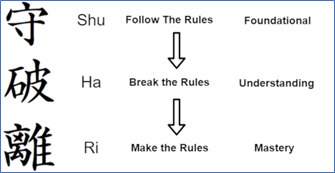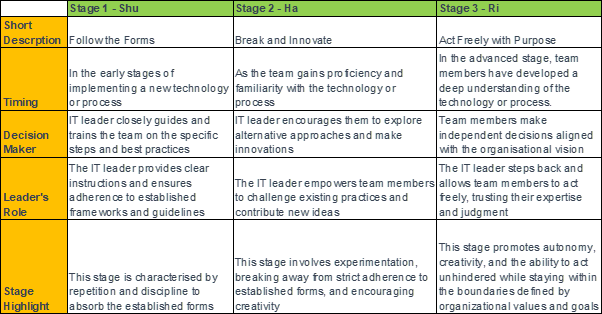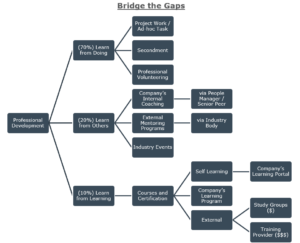Shu-Ha-Ri and Servant Leadership
In today’s rapidly evolving IT landscape, leadership styles play a pivotal role in shaping the culture and success of companies. With unique challenges and demands, it is crucial for leaders to adopt effective approaches that resonate with the modern workforce. Among many leadership styles, there are two prominent styles within IT companies – servant leadership and dictator leadership. Each leadership style has different implications for IT project delivery and for the delivery leads and/or project managers.
What is Dictator Leadership
Dictator (or dictatorship) leadership, despite its negative connotations, can be effective in specific situations (e.g., where discipline and obedience are absolutely necessary). This style involves a more autocratic approach, with leaders making independent decisions and providing clear directives to the team. IT delivery leads may adopt dictatorship leadership during high-pressure scenarios or when immediate action is required. However, it is crucial to balance this style with open communication channels and involving the team in decision-making whenever possible.
What is Servant Leadership
Servant leadership is a people-centered approach that prioritises empowering and serving the needs of the team. IT delivery leads following this style foster collaboration, open communication, and trust-building within the organisation. Creating an inclusive work environment, providing resources and support for team members to excel and offering coaching opportunities are key elements of servant leadership.
What is Shu-Ha-Ri
Shu-Ha-Ri is a concept that originates from the Japanese martial art Aikido. Aikido master Endo Seishiro explains the concept via the following statement:
“It is known that, when we learn or train in something, we pass through the stages of shu, ha, and ri. These stages are explained as follows. In shu, we repeat the forms and discipline ourselves so that our bodies absorb the forms that our forebears created. We remain faithful to these forms with no deviation. Next, in the stage of ha, once we have disciplined ourselves to acquire the forms and movements, we make innovations. In this process the forms may be broken and discarded. Finally, in ri, we completely depart from the forms, open the door to creative technique, and arrive in a place where we act in accordance with what our heart/mind desires, unhindered while not overstepping laws.”
Shu-Ha-Ri is increasingly popular with companies where Agile methodology influences their project delivery ways of working.

Advertisement
[widget id=”custom_html-68″]
How Shu-Hai-Ri Complements Servant Leadership
In the “Shu-Ha-Ri” framework, the servant leader guides the team closely at the beginning (Shu), transitions to a more hands-off approach (Ha), and ultimately reaches the stage where team members can make decisions independently while aligning with the organisational vision (Ri).
Example of Servant Leadership with Shu-Ha-Ri: Estimation
Shu: A delivery lead provides a pre-defined method of user story estimation, and the newly launched Agile development team follow the method in their first month.
Ha: In the second month, the Agile development team members reach out to the deliver lead to learn other estimation methods. They then decide to use a different estimation method under the guidance of the delivery lead.
Ri: Six months later, Agile development team members review all estimation methods and choose another fit-for-purpose estimation method all by themselves, without involvement of the delivery lead.
Playbook of Shu-Ha-Ri

Conclusion
Effective leadership in modern IT companies requires an understanding of different leadership styles and the ability to adapt to specific situations. IT delivery leads must navigate the complex challenges of the industry, drive success and inspire their teams to achieve their fullest potential. By adopting a fit-for-purpose leadership style based on the context, IT delivery leads can create a positive and productive work environment that fosters innovation, engagement and continuous growth. The concept of “Shu-Ha-Ri” provides a “test case” for leadership development and allows leaders to evolve alongside their teams.
Reference:
-
Wikipedia, “Shu-Ha-Ri”, https://en.wikipedia.org/wiki/Shuhari
-
Brian Tait, “Traditional Leadership Vs. Servant Leadership”, https://www.forbes.com/sites/forbescoachescouncil/2020/03/11/traditional-leadership-vs-servant-leadership/


